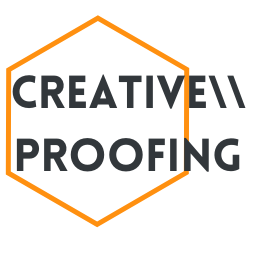I'm Megan J. Robinson, and this is Creative\\Proofing, a space to think, feel, and design out loud. Every Thursday I'll send you a newsletter exploring the intersection of creativity, spirituality, and productivity, and what that looks like for each of us. In each issue of Creative\\Proofing, I’ll dig into various questions, ideas, and topics by sharing what other thinkers, feelers, and doers have said, followed by my take, and then, what it do for us going forward. I’ll also try to throw in reader feedback, recommendations, and maybe something I’m enjoying that week. Stick around to find out more, hmmm?
This newsletter is currently ad-free, and just free. (If that changes in the future, I'll be sure to let you know.) You can reach me anytime by replying to this email, and if someone sent this to you, they may be asking you to sign up as well. You can do that by clicking here.
If you'd like to listen, you can also subscribe to the Creative\\Proofing podcast.
Welcome to Your Heart
First, it's helpful to understand that we have three centers of intelligence - our head, our heart, and our body - and we tend to draw from, or rely on, one of those centers more often than the others. Our greatest potential for growth lies in the integration of all three centers, when we engage each intelligence so that they all work together in concert, rather than atrophying from lack of use.
As we recognize the primary center from which we understand, respond to, and interact with our world, we also recognize that we often ignore or distort the other centers of intelligence available to us. Perhaps without realizing it, at some point we told ourselves that something about those other types of knowing was less trustworthy, useful, or valuable. And so, over time, we focused more intently on our dominant center (sort of like weightlifting on only side of the body while leaving the other side alone - looks kinda weird, right?).
This week, we're focusing on the Heart Center. In ancient Near Eastern and Greek thought, the heart (לֵב, lev; kardia) was considered the primary seat or home of human being, and from the heart flowed thoughts, affections, speech, actions, and life itself. Even today, we frequently refer to our personalities, values, and interests as our identity, as reflecting the "heart" of who we are: the collections and combinations of which are unique, diverse, and sometimes, deeply mysterious.
We'll take a look at our Heart Centers (Emotional Intelligence, EQ) through the lens of the Enneagram, but rather than delve into the specific types, we'll just go over some general observations that connect the types within each center. We'll also take a look at some thoughts on love, which has generally been associated with the heart, and what that means for knowing ourselves, others, and our world.
A Quick Note
I work from within the Christian tradition, and understand the Divine as the Trinity of father, son, holy spirit. That said, I know we all have different ways of understanding the Divine, so if you wish to insert [Other] when I use that phrase, please feel free to do so. Understanding ourselves and others through the Enneagram seems to work well either way.
What Others Say
As Drew Moser defines it, feeling or emotional intelligence is used for "observing emotions in ourselves and others, interpersonal community, and relationship." Those who lead from the Heart Center trust their feelings and relational connections most. They find it distressing when relationships break down, and work to restore their connections by seeking affection and approval. Those high in EQ may sometimes feel that GQ (gut intelligence) folks are a bit judgey, and IQ (intellectual intelligence) folks somewhat unfeeling. Conversely, if you lead from a different center, you may find it difficult to identify or articulate the emotions you experience, or even know what to do about them, or how they help or hinder your relationships with others.
(And let's be clear: everyone experiences emotions (except maybe sociopaths?), and everyone at some point in their lives has been driven by their emotions. Attending to our Heart Center can help us gain greater clarity on what those emotions are, and how to express them in healthy ways.)
As Calhoun and Loughridge observe, our hearts have their own neural system. When that system is healthy, working from the Heart Center includes authentically caring for and investing in relationships without requiring a response from others. When it's not healthy, the Heart Center compels a constant desire for response, approval, and affection from others. If that response doesn't come, it can lead to a perception of the self as incompetent, inadequate, or disconnected.
Beatrice Chestnut suggests that those who primarily lead from their Heart Center experience deep sadness leading to shame, because they perceive that they are not loved or accepted for who they are. Moser describes shame as a "state of painful negative thoughts about oneself, humiliation or distress caused by the experience of being wrong or foolish." This can foster a preoccupation with developing or presenting an "image" to the world in the attempt to be seen, recognized, and welcomed. Because of this preoccupation, the Heart Center can provide a heightened need to connect and a corresponding ability to "read" interpersonal dynamics at the relational level. (I liken this to the whiskers on cats: just like the sensory organs located at each tip of a whisker vibrate in response to the environment, high EQ can help navigate a dinner party or a work meeting in amazing ways.)
When experiencing that sense of shame, it can feel overwhelming, suffocating, and deflating. The only thing that can be seen is the shortcomings, failures, and pitfalls of one's efforts, and how it distances from the connections so desired. The impulse to withdraw and isolate becomes paramount, so as not to risk exposing the "unwelcome" parts. Again, Moser notes, it's a "tragic cycle that drains generative discerning energy, redirecting it at our own self-loathing." This can lead to a sense of loneliness, confusion, and even being "stuck." It may help to remember that we can have the feelings without being the feelings; which is to say, this too shall pass.
But just as the desire for connection and being known can lead us to some unhealthy places, that desire can also be an invitation to listen to the stories and voices that come into our lives, and decide which will be the loudest. Shame and isolation? Or connection and intimacy? David Benner affirms that love
speaks to the depths of our soul, where we yearn for release from our isolation and long for the belonging that will assure us we are at last home. [...] To be human is to have been designed for intimate relationship with the Divine. This is why the yearning for connection is spiritual.
Ronald Rolheiser suggests that the experience of loneliness and isolation could also spur us to consider what might exist beyond ourselves and our immediate concerns, what we might wish give to others, rather than store for ourselves. This could come through service, sacrifice, or even creativity: what does the world need that I can make or provide? The world can be your neighborhood, your community, your home, however you define it. Love, as we will see later, should be understood as a whole-body action, not solely in the realm of the Heart Center. I know The Beatles told us that all you need is love, but actually, I think it's where you start. Welcome to your heart.
What I Say
Since my EnneaType is the Four, I understand leading from the Heart Center very well. From personal experience, I can say that I cherish my capacities for connection, relationships, and understanding emotions (both mine and others). That said, it's also my experience that those same capacities have provided some of my deepest wounds, hardest struggles, and longest lessons over the years. I've had periods of my life when I've numbed myself emotionally, thinking that if I understood the problems, I didn't have to feel the problems. It worked for a time, but excavation was a bitch.
Sometimes I describe myself as an emotional weathervane: susceptible to shifts in the air and liable to wild swings depending on the people I'm with, or the currents in the room. When I'm in a good space, I recognize these shifts and hold them loosely, knowing that I can maintain equilibrium. When I'm not in a good space, everyone's problems become my problems, and sometimes it takes a while to realize that I've absorbed all these emotions into my own. All of that to say, I'm great to have around if you want to kvetch, cry, or otherwise vent.
I share this because I see great value in giving space and attention to our emotional intelligence, recognizing that some may have to travel farther to do so than others. While staying in some emotional spaces may not always be healthy, I hope you'll find ways to validate that those emotions are yours to feel, express, and connect with others as you see fit.
What's It All Mean?
So, to recap - the Heart Center includes:
being highly relational, in tune with emotions & connections to others
recognizing that feelings can sometimes overwhelm & betray other truths
recognizing that over- (or mis-) use can lead to oversensitivity, insensitivity, or emotional manipulation
Knowing that anxiety & stress can manifest as shame
If you already lead from your Heart Center, this may feel like old news. But perhaps you've wondered how to gain some objectivity, or help others identify and articulate their own emotions better. Or perhaps you just want to gain some skills in navigating your relationships. Here's some ideas.
When you find yourself getting "emotional," don't write that off right away. If you can, take a few minutes to sit (or walk) with it, and notice how it ebbs and flows across your awareness. If you need to get back into a conversation or situation, take a few moments to practice box breathing as a way to let the emotion wind down, rather than stuffing it away in a dark corner.
At the end of the day, take a few moments to reflect on your experience of those emotions: what was the first one you felt? What about the secondary emotion? (If you're a parent, think back to the last time you snatched your kid from the jaws of death: you probably started yelling at them for being careless (anger), and that was probably actually driven by sheer terror.) Make a note of the circumstances around those emotions: was there something that could have redirected the situation? Is this how you typically react in similar circumstances? Is there something you'd like to do differently?
If you find that you can't even identify what you're feeling (or if someone else has that difficulty), buy or make "emotion (flash) cards" or duplicate this Notion template to help you pick out the ones you're feeling at the moment. Even just that practice of sorting through options can help provide some distance, clarity, and calm, which may take off some of the pressure to get things figured out right away.
Above all, here's what I hope you take away today:
A Healthy Heart Intelligence reminds us to connect with and consider others, trust our values, and cultivate vulnerability in our relationships.
Creative\\Responses
Got a question, feedback, or something to share? All you have to do is reply to this email and write me! (Be sure to let me know if you want to remain anonymous, or if it's ok to use your first name.)
Creative\\Recommendation
With exercise studios and gyms more or less unavailable, I've had to get creative with moving regularly and keeping myself in some sort of shape. These two YouTube channels have saved my butt from spreading across the couch over the last year.
Creative\\Enjoyment
Baby Yoda is life. (It's a Western! In space!)
Tell your friends.
If you’d like to support Creative\\Proofing, the best thing to do is spread the word. If you think of five friends who might enjoy this, forward this email to them! Degrees of gratitude may vary, but please know, my gratitude is infinite.
You can share Creative\\Proofing on all the socials. You can also follow on Instagram @R21.5Coaching.
Shalom!






